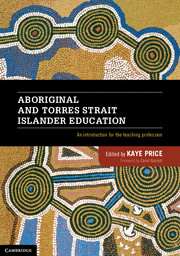Book contents
- Frontmatter
- Contents
- Contributors
- Acknowledgements
- Chapter 1 A brief history of Aboriginal and Torres Strait Islander education in Australia
- Chapter 2 The Stolen Generations
- Chapter 3 Delivering the promise
- Chapter 4 Your professional experience and becoming professional about working with Aboriginal and Torres Strait Islander students and communities
- Chapter 5 The ‘silent apartheid’ as the practioner’s blindspot
- Chapter 6 Better
- Chapter 7 Maths as storytelling
- Chapter 8 Information and communication technologies in the classroom
- Chapter 9 Language and literacy
- Chapter 10 Aboriginal and Torres Strait Islander Studies in the classroom
- Chapter 11 Engaging Indigenous students
- Appendix A Take a book: Any book
- Appendix B1 Terminology
- Index
- References
Chapter 7 - Maths as storytelling
Maths is beautiful
- Frontmatter
- Contents
- Contributors
- Acknowledgements
- Chapter 1 A brief history of Aboriginal and Torres Strait Islander education in Australia
- Chapter 2 The Stolen Generations
- Chapter 3 Delivering the promise
- Chapter 4 Your professional experience and becoming professional about working with Aboriginal and Torres Strait Islander students and communities
- Chapter 5 The ‘silent apartheid’ as the practioner’s blindspot
- Chapter 6 Better
- Chapter 7 Maths as storytelling
- Chapter 8 Information and communication technologies in the classroom
- Chapter 9 Language and literacy
- Chapter 10 Aboriginal and Torres Strait Islander Studies in the classroom
- Chapter 11 Engaging Indigenous students
- Appendix A Take a book: Any book
- Appendix B1 Terminology
- Index
- References
Summary
After finishing my PhD in applied mathematics, I received a phone call from Professor Tom Cooper and Dr Annette Baturo from Queensland University of Technology (QUT) trying to enlist me into mathematics education projects focusing on Aboriginal and Torres Strait Islander students. The first question they asked me (a bit tongue in cheek) was: How can you exist? They qualified by saying that, according to statistics, Aboriginal and Torres Strait Islander students are severely underperforming in mathematics but yet you, an Aboriginal man, have a PhD in applied mathematics. How can that be? I was perceived as an anomaly: a glitch in the system.
My personal experience with education was one of survival. During my education, I was the only Aboriginal student in the class and from an early age had to endure racial taunts from students. During my high school years, these taunts also came from the teachers, which gave additional power and justification to the racist attitudes of students. If I defended myself I was only told to sit down and shut up. During this period I did have a supportive circle of friends, but experiences around race and identity were rarely discussed, and anyway, I was not open to do so. I learnt to be silent; to not make a fuss and to avoid, if possible, any subject that dealt with society, particularly history. These experiences left me vulnerable, with potential to disengage from education; my future and my place in society as an Aboriginal person was not clear.
- Type
- Chapter
- Information
- Aboriginal and Torres Strait Islander EducationAn Introduction for the Teaching Profession, pp. 94 - 112Publisher: Cambridge University PressPrint publication year: 2012
References
- 6
- Cited by



